Cultural Production in Theory and Practice
“Doing” Culture
Cultural production is the magic word in our teaching and research. It appears in the title of the international MA programme. It is also a lived experience in the context of the students’ master theses. But what exactly does the term refer to?
We are all constantly involved in producing culture. While living our everyday lives we use cultural material and imaginary resources in a unique way to serve our purposes. When we get dressed, go to work, communicate with others, organize our spare time, etc. we rely on, reproduce and modify the norms and values underlying our social and cultural relations. Our daily routines seem natural and self-evident to us and we don’t usually think about the fact, that while carrying them out exactly in the way we do, we appropriate and articulate culture. This productive side of our everyday routines, our “doing culture” is often hidden from view. It is precisely this seemingly natural state of affairs that more often than not leads to the reproduction of what is. Our ordinary, standardized activities prevent us from reflecting the internalized patterns they express and they undermine the search for alternatives.
To become an active producer of culture entails the attempt to overcome these shortcomings. When “doing” culture consciously, we try to think about the contexts and conditions that govern our cultural activities and to reflect on the effects these have. Producing culture actively, thus, entails to think about the stance, the point of departure from which we act. It requires to think of the values, collective norms and invisible rules that guide our behaviour and to reflect on the social and cultural positioning of our activities. Finally, it encompasses a claim to participate in the formulation of the norms and values that govern society, to take part in its decision-making process about who or what counts as important or unimportant, as good or bad and to change the rules by which social and cultural relations are reinforced. Products of such activities – works of art, DIY cultural forms, etc. – irritate and challenge the way we “normally” see and do things. Today a host of contemporary art productions exist that aim to reflect on and interpret our cultural contexts and the underpinnings of our daily routines (see the articles by Siglinde Lang and Elke Zobl on the “Matrix of Cultural Production” and on “Art goes Culture” in this volume).
Cultural production in this sense can be understood as an intervention in the process of producing meaning. Since this process is one of constant reshaping and redefinition, it has been called “the circle of meaning production” within cultural studies. This circle addresses the sides of production, product and consumption alike and stimulates questions such as: Where and when did a cultural artefact originate? Which legal, economic and political forces govern and restrict it? How does it express the existing power relations in society? Why was it produced and by whom? Who consumes and appropriates it and for what reason? Answering these questions promotes an awareness of the different forces that are involved in shaping our culture and that determine the effects our cultural productions will have. Being aware of the different moments in the circle, thus, constitutes a prerequisite for actively changing the production of meaning in society and giving a voice to new ideas.
The international MA programme in Cultural Production aims at providing artists and other cultural producers with the theoretical and practical means for such an active examination of culture. On the theoretical side it has attempted to raise awareness for the different moments in the circle of meaning production and provided its participants with information and knowledge on its workings. Given this broad understanding of the term cultural production it becomes immediately clear, that a work of art or a media text cannot exist in any meaningful sense unless there are consumers, spectators and audiences, who consume, interpret or co-create this product. Thus, reflections on art mediation and audience development are part of the business plan developed by the participants of the Master programme – as well as an environmental analysis, an arts marketing and PR strategy, a SWOT analysis, the budget needed, etc…
The business plan itself is part of a project that in turn is theoretically grounded in the ideas of culture as a lived, constantly changing and shifting thing produced in everyday life. Since active cultural production depends on such reflections, it always involves our identity and thus entails a moment of personal change and growth. Often such products are done collaboratively, since cooperation is a prerequisite for finding one’s own unique voice when aiming at intervention and change. The MA provided such a common ground for developing the projects and it was amazing to see how people stemming from different nations and cultures, from different sections of art and media, from different political and social stances managed to form a productive group that took interest in each other’s work, helped it along and developed an empathetic attitude towards each other. This is exactly what we mean, when we talk about cultural production as a lived experience.
(Elisabeth Klaus)
MA Thesis projects developed with the ULG MA in Cultural Production 2010-2012 at the University of Salzburg
The ULG MA in Cultural Production is an extraordinary program for further education at the University of Salzburg. By focusing on the interconnections between art, culture and media as well as political, economic and social processes, it balances innovative cultural theory with practice-oriented methods. The ULG MA in Cultural Production is a two-and-a-half year, part-time program for further education (90 ECTS) and is held in English. It is open to domestic and international students. The trans-disciplinary curriculum lies at the intersections of art practice, cultural and communication studies and a social science approach to economics.
The first program has started in fall 2010 and is now coming to an end. According to their personal interests, students have proposed their own project ideas and have further developed and implemented them throughout the course of the program for their MA Thesis – which they present in the following.
Content of the program
The art and cultural sectors are currently undergoing challenging processes of change. In the face of advancing globalization and due to new media having become more advanced, the distinctions between high and popular culture have become increasingly blurred. Economic, legal and political conditions vary internationally. New forms of work respond to these changes and trans-disciplinary interaction across regional and national borders shapes everyday work patterns. These factors demand new professional qualifications.
A working knowledge of cultural studies, artistic practice, project management and cultural economics are needed more than ever for the realization of sustainable cultural projects. The ULG MA in Cultural Production responds to such challenges. By defining culture as a daily practice, a specific form of artistic expression and as a site for new media production, the program analyses cultural production within its wider context. The range of activities undertaken by cultural producers is diverse: Cultural producers are specialists who lead the activities of cultural and arts initiatives and create, develop and initiate new cultural projects – mainly in evoking and creating collaborative processes.
The potential of cultural production to build interventions in the contexts of society, economy, media and politics presupposes a complex understanding of cultural conditions and connections. The aim of the ULG MA program in Cultural Production is to consciously shape and control the process by which cultural products develop and are realized on the basis of a critical engagement with contemporary cultural production. Contextual interconnections and the effects and potentials of change are analyzed and new ways of conceptualizing them are researched. The program has been designed to emphasize key qualifications that are required for cultural producers in the constantly changing art and cultural sector.
This MA is situated in the tradition of cultural studies as it has been developed by the pioneering work of the Birmingham Centre for Contemporary Cultural Studies (CCCS). Since then, the field of cultural studies has diversified and grown immensely. In its inter- and trans-disciplinary approach, it combines a variety of disciplines, including art history, communication, sociology, and political economics. In this MA program, we emphasize the variety and multiplicity of cultures in societies. The program draws on a conception of culture that defines it as both a product and a social process of how we interpret and understand the world (culture as „a whole way of life“, R. Williams). In this tradition, culture is seen to be lived, historically formed and changing over time and across space. We conceptualize cultural production as “encompassing a wide variety of artistic forms of expression and disciplines (including fine art, theatre, music, dance and public art), as well as cultural and media practices (like alternative media, Web 2.0 and culture jamming), all in relation to their social, political and historical contexts. We reject the point of view that restricts the definition of culture only to high culture, instead we view cultural production in its multiplicity as a daily practice and within its contextual embedding.
MA Thesis projects from the cohort 2010-2012
The first ULG MA in Cultural Production started with an exciting and very lively atmosphere in the fall of 2010. Full of enthusiasm and ideas, students from various parts of the world – Armenia, Austria, Bosnia, Bulgaria, Canada/Netherlands/Spain, USA/Mexico – began to develop their cultural projects.
Throughout the course the MA thesis projects have been developed within five modules:
Module 1: Art, Culture and Communication
Module coordinators: Elisabeth Klaus, Siglinde Lang, Elke Zobl
Within a cultural studies framework, key theoretical and practical understandings of cultural, communications and media theories with an emphasis on the intersections and connections between aesthetics, art, society and cultural production, have been studied.
Module 2: Cultural Economics, Politics and Law
Module coordinator: Monika Mokre
The main aim of this module has been to explore cultural production in the context of its economic, political and legal environment at local, regional, national and EU levels. By using case studies, the ways in which productions of art, culture and media influence economics, politics and law have been discussed.
Module 3: Cultural Management Processes
Module coordinator: Siglinde Lang
This module presented a process-oriented approach to management that breaks down the boundaries between cultural production and management-based theories of organisation and communication. Contemporary strategies and methods in the areas of fundraising and sponsoring, audience development and marketing, mediation of art and culture and cooperative project management have been studied and implemented.
Module 4: Topical Focus
Module coordinator: Elke Zobl
Students attend a three-week internship that corresponds to their personal interests with an Austrian or international organization in order to get expertise in one of three different topical clusters: Space & Location, Vision & Change and Networks & Decentralization.
Module 5: Research Semester
In the process of writing their MA Thesis’, each student is supported by coaches and supervisors. To receive the MA degree, participants of the program have to successfully defend their thesis and pass the final exam in front of a commission.
(Introduction by program directors Elisabeth Klaus and Elke Zobl)
Visual impressions from the MA course
Compiled by: Roswitha Gabriel
Photographs by: Pia Streicher
-
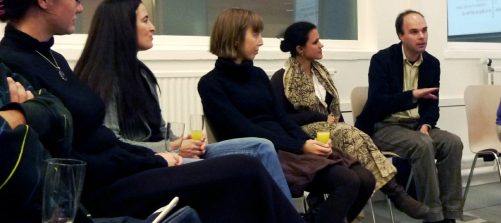
- On September 14th 2010, the first meeting took place: David Röthler (expert for web 2.0 and lecturer: „Work in progress“), Sandra Chatterjee (lecturer „Contemporary Art Discourse, Part 2“, www.sandrachatterjee.net), and the students Sophia Karwowski, Helga Palasser, Ingeborg Patsch (from the right).
-
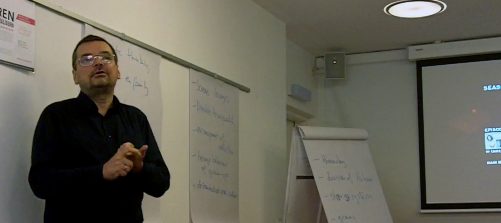
- Diedrich Diederichsen is a Professor for Theory, Practice and Communication of Contemporary Art at the Academy of Fine Arts in Vienna and was teaching „Contemporary Art Discourse, Part 1“.
-
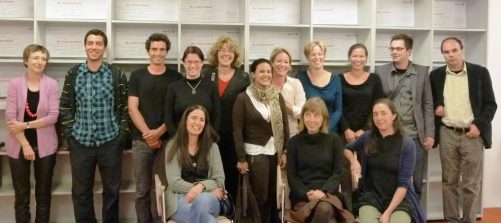
- Back row, from the left: Lecturer Hildegund Amanshauser (Director of the Salzburg International Summer Academy of Fine Arts, teacher for Arts & Society and „On curating“ , Student Ivaylo Botushanov, Lecturer Jens Badura (www.konzeptarbeit.at, teacher for „Aesthetics & Communication“), Student Ingeborg Patsch, Elisabeth Klaus (Program director and teacher for „Work in Progress“), Siglinde Lang (coordinator and teacher for „Work in Progress), Sandra Chatterjee, Elke Zobl (Program director and teacher for „Work in Progress“), Birgit Breninger (expert for Cultural Studies, teacher for „Cultural Production & Cultural Studies“ and „Work in Progress“), student Emin Bahtic, David Röthler (expert for web 2.0 and lecturer: „Work in progress“), students Helga Palasser, Sophia Karwowski, Haydee Jimenez
-
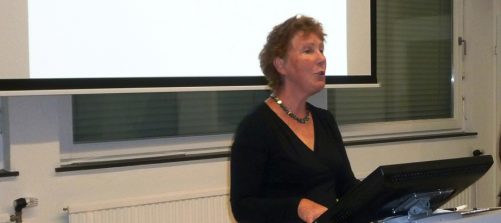
- Barbara O’Connor, Senior Lecturer in the School of Communications at Dublin City University: Guest Lecture „Riverdance“
-
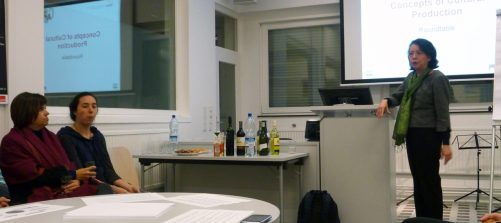
- Monika Mokre (coordinator and teacher for „Cultural Politics“) is doing an introduction into Module 2.
-
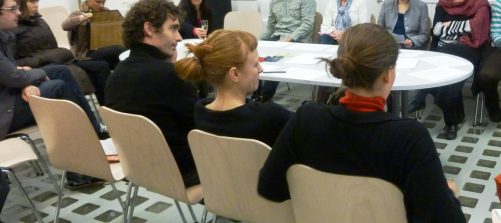
- Round Table at the beginning of Module 2: Student Inge Patsch, Program director Elke Zobl, Lecturer & Coordinator Siglinde Lang, Student Ivaylo Botushanov, Student Helga Palasser, Lecturer Sandra Chatterjee, Student Sophia Karwowski, Student Emin Bahtic, Lecturer Jens Badura, Lecturer Elisabeth Mayerhofer („Cultural Politics“), Lecturer Birgit Breninger
-
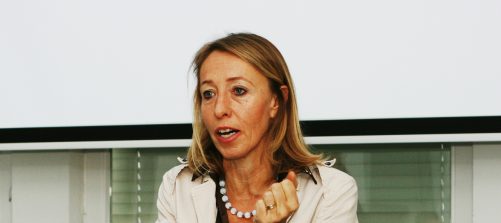
- Birgit Mandel: specialist for Audience Development, she was teaching „Marketing, PR & Audience Development“.
-
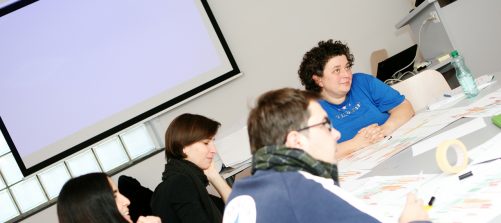
- Carmen Mörsch is the Head of the Research Institute of Art Education (IAE) at the University of Arts, Zurich, she was teaching „Mediation“.
Links:
MA Thesis projects
Haydeé Jiménez Mac Farland – Q-Hatch & the QBC Method: Revising Knowledge Production
Lesley Telford – Using the museum as a performance space for dance; Nomadism
Emin Bahtić – Dancin between Cultures. The Role of Bosnian Folk Dance for Juveniles ins Salzburg’s Bosnian Diaspora Community
Emin Bahtić was born in Travnik, Bosnia and Herzegovina. He studied English language and literature and marketing (graduated) at the University of Sarajevo. Since 2009 he lives in Austria and currently attends the MA Cultural Productions at the University of Salzburg/ Mozarteum Salzburg. He is particularly interested in video art.
The thesis discusses the role of the Bosnian cultural background of juveniles between 14 and 20 years old in the Bosnian diaspora community in the city of Salzburg/ Austria – a relevant topic in the light of current debates on diaspora communities in Austrian politics, society and media. The research question focuses on how young people from the Bosnian diaspora community in Salzburg perceive and sustain their cultural background, with cultural background being conceptualized as a set of activities referring to the “home country”, whereby all juveniles in focus were born in Austria. Concepts of “community”, “diaspora” and “culture” are discussed on a theoretical level and are contextualized in the thesis’ overall frame. A qualitative case study, employing participatory observation and semi-structured interviews with youngsters attending Bosnian folk dance classes at the folk dance club KUD Behar, allows to get a deeper insight into the role of Bosnian customs and traditions. The aim is to put a new perspective on the cultural lives in diaspora communities by letting members of the community in focus talk; this is something that is frequently neglected in respective research in the field. The thesis examines the underlying motives of youngsters to attend folk dance classes, as well as the meaning of folk dance for their daily lives. It finds that folk dance is a vehicle to keep up the connection with the perceived former “home land”, while at the same time it is not the maintenance of customs and traditions, but rather socializing with similar-minded friends which is the main reason to attend the classes. The thesis concludes that nevertheless, folk dance provides an important stimulant for young people from the Bosnian diaspora community, it plays an important part in their daily lives and finds its expression through objects such as special clothing, photos or listening to the respective music.
The thesis also prepares for a video workshop, which will be carried out between November 2012 and March 2013 in Salzburg. During this workshop, the attendants of the Bosnian folk dance classes at KUD Behar are invited to make short videos through which they can express the role of folk dance and Bosnian customs and traditions for their daily lives as members of the Bosnian diaspora. The short videos will then be included in a documentary about the workshop, which will be presented in March 2013 in Das Kino Salzburg, the local arts cinema. The project is the practical and artistic application of the thesis and discusses the research question with the Bosnian youngsters from KUD Behar from a creative perspective. It will be carried out in cooperation with Studio West Independent Salzburg, a local film studio, and Nicole Baïer, a film producer, artist, and experienced film workshop teacher.
Supervisors
Elke Zobl/ Florian Bettel
Elisabeth Klaus
Link to presentation/documentation:
http://www.studio-west.net/video-in-the-box (start of project: November 2012; end: March 2013)
March 2013, at Das Kino Salzburg (www.daskino.at)
Cooperating Institutions:
Studio West Independent Salzburg and Nicole Baïer
Haydeé Jiménez Mac Farland – Q-Hatch & the QBC Method: Revising Knowledge Production
In order to explore the potentials of knowledge creation processes and its connection to the production of culture and artifacts, this paper puts into question the discourse of knowledge production and its relation to power and language. In particular, the value of knowledge is juxtaposed with the discourse of doubt and criticality through the creation of the Q-Hatch project and QBC Method which focus on the act of proposing questions, not in the search for in- depth knowledge and answers, but to revise existing knowledge in order to form new and alternative possibilities to what is already known. The search for truth, the reliance on belief systems and the creation of answers and explanations has long been a force that has dominated social systems and processes throughout time. Since the beginning of philosophy, questions have been asked and answers have been searched for, ideas discussed and conclusions and definitions have been created. The production of knowledge was in the hands of those who held elite positions which allowed them to acquire the tools and positioning to develop, share and record thoughts. Today’s Information Society and Knowledge Economy allows for the development of new ways for people and communities to interact with information, giving way to multiple approaches to information and practices around the sharing and production of knowledge. Mobile technology, ever more present in the daily lives of people across the globe, can bring information to the palm of a hand. The meaning that is produced is dependent on the actual design of the interface and information, which in-turn, is affected by a complex web of social and environmental relations. If information and how it is perceived and processed by an individual or community is reliant on where it comes from, when it was created and how it was received (meaning by which medium), then information’s only constant is change. Why then do we seek fixed answers and single solutions in existing knowledge? How does discourse get created and transformed into mechanisms of power? What would happen if new forms of discourse aimed at deconstructing knowledge, instead of simply improving it? The Q-Hatch project proposes the application of a combination of techniques such as questorming, brainstorming and critique (the QBC Method) in an online setting where chosen issues at hand can be dissected, deconstructed and revised in order to reach alternative possibilities to existing knowledge. In other words, Q-Hatch emphasizes on the value of exploring the unknown – the waiting room for innovation and the future.
Sophia Karwowski – Musical Participation: A Historical Contextualization of Music and Sound Art-Based Participatory Projects
Sophia Karwowski is an arts administrator and flutist from New York City. She holds a Bachelor of Music degree from McGill University in Montreal, Canada.
This thesis explores music and sound art projects that use strategies of participation, active engagement, collectivity, and mediation that move beyond traditional performance conventions, and contextualizes them within the larger participatory art discourse. Using a representative chronology of project examples and theoretical literature spanning the past century, an analysis of the changes in the concept of participation over time is developed. Three contemporary projects are analyzed with recourse to this research, including Echolocation, an original psychogeographic and participatory sound art project in the New York City subway. Attributes under examination in these projects include their larger social context, the negotiation of roles between spectator and artist, the production of meaning, and changes in performance contexts. The ramifications of innovative participatory strategies in the music world are discussed in relation to audience engagement and in a larger context of equality and exchange.
Supervisors:
Hildegund Amanshauser
Elke Zobl/Florian Bettel
Helga Palasser – Setting Intercultural Concepts to Work – the “Stone Diary” an art exchange between Zimbabwean and Austrian Sculptors
Helga Palasser’s professional education is twofold. She did a diploma in tourism economics and an apprenticeship in sculpture. In September 2010 Helga joined the programme for cultural production, where she is now working on her project .
As a sculptor with a strong interest in foreign cultures and creative art processes my research interest gave rise to my project idea and the research question. Personally, I have been motivated by a desire to know how an artistic intercultural exchange would work in practice. What happens when two artists having different cultural backgrounds meet? Are there any ways to facilitate this process and what intercultural differences would hinder the final outcome of the encounter?
The project which serves as a case study for my thesis is entitled the “Stone Diary” and will canvass an intercultural meeting involving an art exchange. It is an intercultural artistic collaboration of four sculptors, Allan Tapfumaneyi Tapfumanei, Rufaro Murenza, Liberty Tshuma from Zimbabwe, and myself from Austria. This artistic project starts with a personal exchange of artistic knowledge and the creation of works of art related to our life-stories, with the topic “faces and places“. These will be documented in an artbook, which will serve as an advertising tool for the stone sculpting workshops combined with a travel to Africa. The workshops take place annually at the Chitungwiza Arts Centre and will be a fabulous opportunity for a public with a particular interest in art to learn about this unique kind of sculpting.
Accordingly the research question was:
- How can an artistic cooperation between an European and a Zimbabwean artist be developed in an interculturally sensitive way: The case study “Stone Diary”?
Sub-questions:
- To what extent will cultural differences affect our collaboration?
- In what ways can this cultural encounter be fostered in order to be rewarding for both parties?
The main research aim is to offer new perspectives on intercultural competence with a particular focus on how intercultural sensitivity including its challenges and possibilities can be developed in a personal and process-oriented way. To realise this aim my research work will be supported by practical experience. From the scientific perspective I intend to apply concepts from the field of intercultural competence and communication concepts, as well as an artistic endeavour with the help of project management methods. In addition, I hope to illustrate the problems and possibilities of our artistic collaboration and find ways to facilitate artistic co-operations between different cultures.
Aims of this undertaking are the following:
- to experience intercultural exchange on a personal level
- initiate new artistic and cultural growth
- to explore the differences and similarities that come out of this process
- to spark interest in other cultures
- making people visible through the creative art process
- to develop partnerships
- to establish a community with a particular interest in intercultural processes
- to address the misconceptions we often have towards other cultures
- to promote intercultural dialogue through personal experiences as an artist
- to raise dialogue on integration, racism and policies concerning culture
Summary of the investigation process:
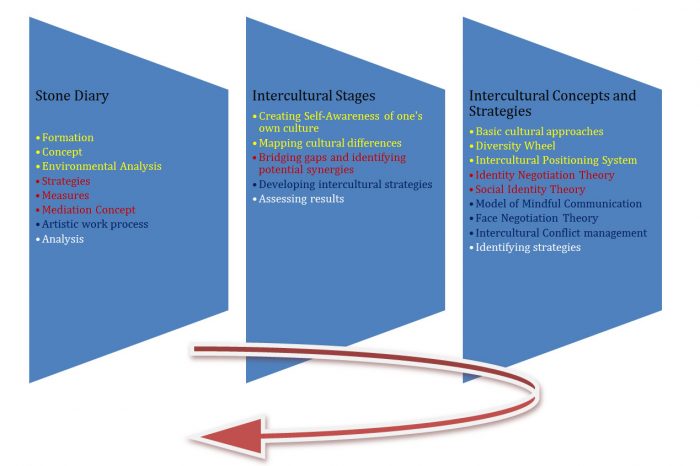
Figure 1: Summary of the investigation process concerning finding ways to develop the project “Stone diary” in an interculturally sensitive and competent way. (The middle part: “Stages of building culturally diverse teams” from Varner and Beamer (2011: 466) adapted by Palasser (2012)
The figure below is a pictorial summary of steps I have taken in answering the research question. I have used a colour coding system to indicate the stages where a given intercultural strategy is most applicable – e.g. using the diversity wheel and the intercultural positioning system for building awareness in the start-phase of the project, followed by strategies like the identity negotiation theory to explore the subject in depth and recognize the connection between these areas.
Supervisors:
Birgit Breninger
Elke Zobl/Florian Bettel
Form of presentation/documentation:
The artbook “Stone Diary” will be available soon, a slideshow/documentation of the artistic process is online: www.palassart.com
Link to presentation/documentation:
www.palassart.com/?p=427
Cooperating Institutions:
Chitungwiza Arts Centre
Cooperating Artists:
Allan Tapfumanei
Liberty Tshuma
Rufaro Murenza
Helga Palasser
Ingeborg Patsch – Prospects for Establishing a Social Media Network for Cultural Communities in Rural Areas. A case study about a specific social media network in the region of Pinzgau
Initiator and manager of socio-cultural projects, with a strong background in information and communication technology.
This Master’s thesis deals with the question: Which role can Social Media Networks play in improving the situation of existing cultural communities in rural areas?
In this respect, cultural communities are defined as a group of people who communicate with each other about an issue of interest (the social object). Social Media are not only analyzed concerning their technical manifestations and organizational aspects, but also regarding their social meaning and how they influence group dynamics and existing social systems.
The methodological framework used for this purpose is Hollingsworth’s model of institutional analysis. In short, this model assumes that we can analyze any situation based on five levels. This approach allows a socio-economic as well as a socio-political point of view and enables us to include and question rather general aspects like norms, values and habits within the same framework with which very specific organizations are scrutinized.
Based on the above model, chapter 2 begins by defining what is understood as culture and which parts of it will be reflected on in this Master’s thesis. Briefly stated, it is the culture produced during leisure time, from which the better part is produced in the third sector. The Image Culture Image Leisure Time System shows how the sectors overlap and where culture can be identified. Chapter 2 ends with an analysis of Social Media within the framework of institutional analysis. This analysis shows the constraints which influence the development and usage of Social Media. Continuing on the level of organization, two dimensions are reflected on: firstly, what form of organizations normally run Social Media infrastructure and secondly, which processes of (other) social groups (communities, networks, businesses …) can be reproduced and improved by Social Media.
Chapter 3 lays the foundation for understanding the case study more easily. This case study is the Social Media Network IBinPinzgau which took place in the Region of Pinzgau. Therefore, chapter 3 gives a close description of this region. It starts with general information like economic performance and education which is followed by an analysis of the region based on the aforementioned institutional analysis. Firstly, assumptions about values and habits influencing the behavior of actors with regard to culture are made. Secondly, the political and economic structures with regard to cultural productions are analyzed. Thirdly, a brief overview of current cultural organizations illustrates the setting of the cultural area of Pinzgau. Chapter 3 is rounded off by analyzing four fields in which culture faces problems or challenges: financing, its relation to tourism, its satisfaction with choices and possibilities and barriers to participation.
Chapter 4 starts with a description of the Social Media Network IBinPinzgau. IBinPinzgau is planned to be a meeting point for artists, creative people and people interested in culture produced in the region. This very specific part is followed by an analysis of the experiences as operators of such networks. Challenges and risks were reviewed on the basis of specific examples as well as on a theoretic level. Operators have to take the three aspects organization, financing and awareness into consideration while dealing with the Social Object as the central issue. At last, chapter 4 answers the question with regards to the problems described in chapter 3. Briefly stated, on the one hand, Social Media can increase connectivity and be a matrix for awareness. On the other hand, Social Media cannot solve problems which have their roots in the existing structure or which lack power. For those, in a best case scenario, it can serve as an additional tool, but not be the solution itself.
Supervisors:
Monika Mokre
Elisabeth Klaus
Link to presentation/documentation:
www.ibinpinzgau.at
Cooperating Institutions
Akzente Pinzgau
Musikfabrik
Tauriska
Regionalverband Oberpinzgau
Lesley Telford – Using the museum as a performance space for dance; Nomadism
Canadian, based between Spain and the Netherlands; she has most recently danced with Netherlands Dans Theatre and presently works as a choreographer.
The museum has increasingly become a desired setting and mode of discourse for dance. However, despite some exceptions, dance as a discipline is caught between the product-oriented system of repertory companies and isolated independent dance projects which are generally limited in funding and often remain small-scale in terms of exposure. Since performance, particularly dance, is normally created for the theatre, the practicality of producing performance work for the museum is challenging. Although museums are interested in performance, independent dance artists continue to rely on the theatre as an institution for production support and the majority of funding.
The museum is a space in which the relationship between the performer and the spectator may be explored as a permeable exchange. The investigation lies with questioning how a performative situation may be produced to encourage an emancipated spectator. This concept of emancipation is described by Rancière as, “the blurring of the boundary between those who act and those who look” (2009: 19). Considering the museum as a setting in which the constellation of elements may be optimized for the experience of the emancipated spectator, what are the possibilities and constraints of the given institutional, practical and financial context?
I refer to the theories of Rancière (2009), Fischer-Lichte (2008) and Lehmann (2006) as a theoretical base regarding the emancipated spectator, the performative turn and the “event” nature of performance, respectively. These theories will be used as a base from which to look into existing models of cultural production studies. Models of the circuit of production are proposed which are adapted to include the concept of a live “event”. In investigating the influences on the performance event in a museum, research is directed towards cultural politics, the mission of museums and funding scenarios. These factors shape the curatorial choice towards performance and how it is incorporated into the agenda of a museum.
In conclusion, the emancipation of the spectator is encouraged through situations which lead the spectator to find his or her own associations, creating one’s own narrative (Rancière, 2009). In pushing the boundaries of where a work “belongs” the spectator is required to re-situate his or herself. The use of the museum as a performance space may be a site of discourse where expectations are shifted and the relationships of all elements in the constellation redefined by all. This includes the space and time situation of the work, the performer-spectator relationship, the spatial context and the institutional relationship with the artwork, artist, and publics. In attempting to fully integrate a project proposal including performance in a museum context, an artist ideally needs a collaborative relationship with the institution. The theories of New Institutionalism are based on principles of open exchange with artists which trickles down to the relationship with the spectator, encouraging an emancipated experience. Decentralized networks of small institutions rather than large national centralized institutions may be more conducive to this goal providing a sufficiently flexible infrastructure for developing performance work. The development of relationships with institutions is based on trust, growth and continuity. Just as artistic collaboration is deepened through long-term relationships, institutional collaborations with artists develop over time. This has artistic benefits as well as the advantage of sustainability in an ephemeral and under-funded field.
Supervisors:
Jens Badura
Elisabeth Klaus
Link to presentation/documentation:
lesleytelford.com/project
Vernissage/presentation:
[20/11/2012], Festival Internacional de Madrid en Danza
Cooperating Institutions:
Festival Internacional de Madrid en Danza, Spain
Teatro Canal, Spain
Korzo Theatre, Netherlands
Cadance Festival, Netherlands
Chutzpah Festival, Canada
Cooperating Artists:
Yoko Seyama
Iratxe Ansa
Clyde Archer
Miguel Olivera
Fischer-Lichte, Erika (2008): The Transformative Power of Performance. Translated from German by S.I. Jain. Abingdon / New York: Routledge.
Lehmann, Hans-Thies (2006): Postdramatic Theatre. Translated from German by K. Jürs-Munby. Abingdon/ New York: Routledge.
Rancière, Jacques (2009). The Emancipated Spectator. Translated from French by G. Elliott. Brooklyn/ London: Verso.
Elke Zobl, Elisabeth Klaus ( 2012): Cultural Production in Theory and Practice. In: p/art/icipate – Kultur aktiv gestalten # 01 , https://www.p-art-icipate.net/cultural-production-in-theory-and-practice/


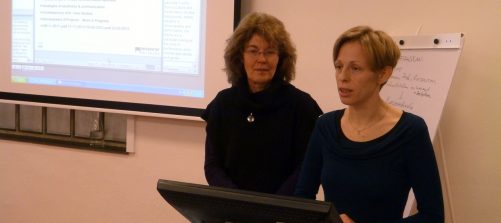
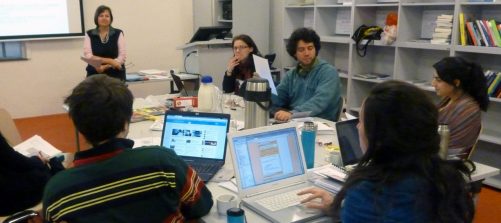
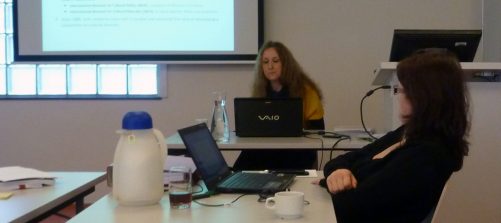
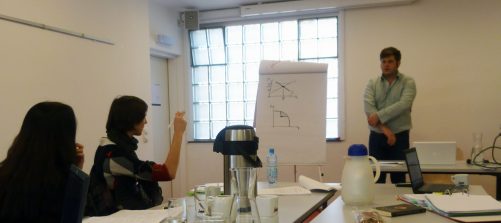
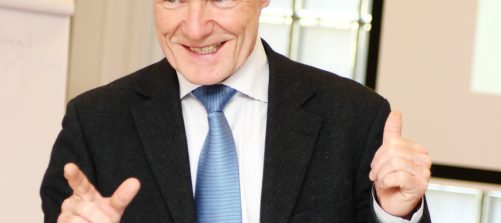
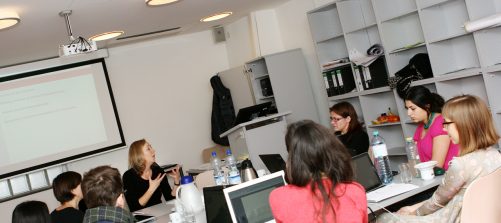
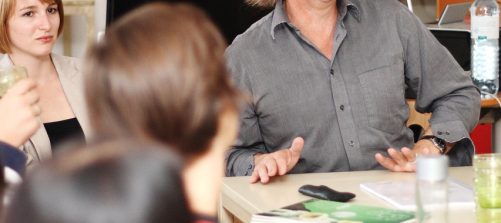
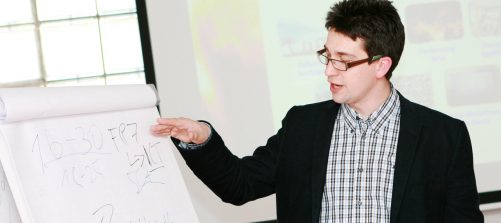
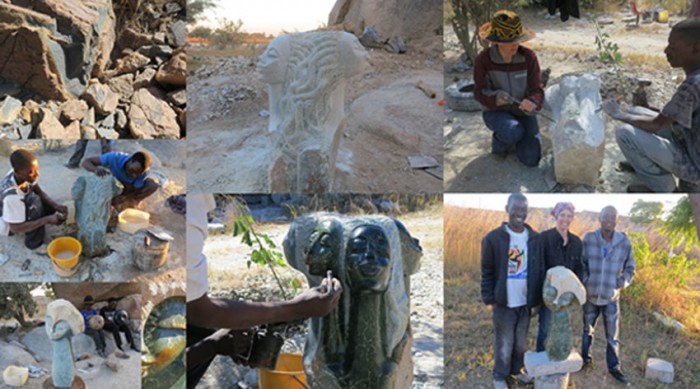
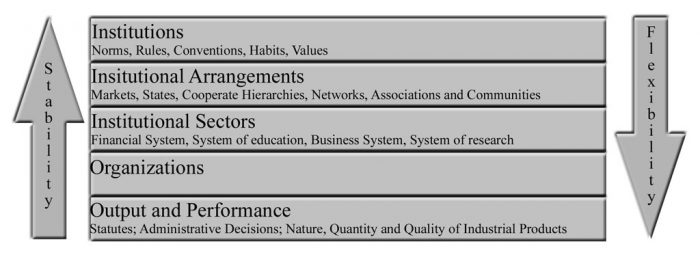
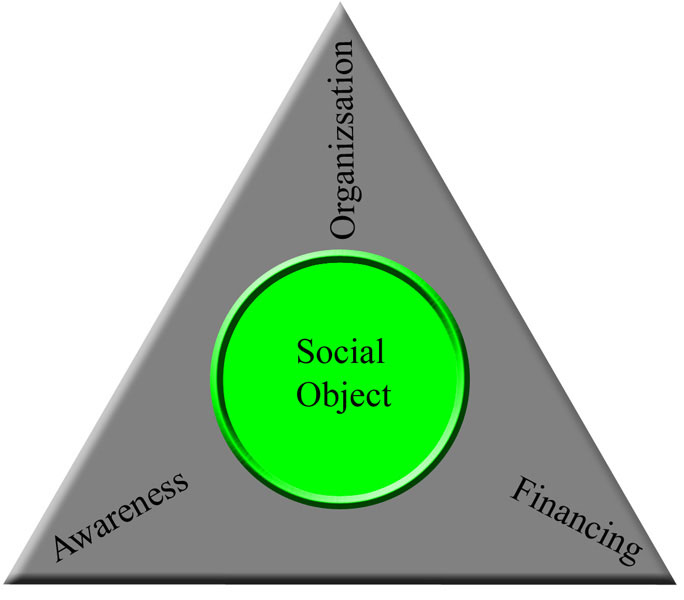
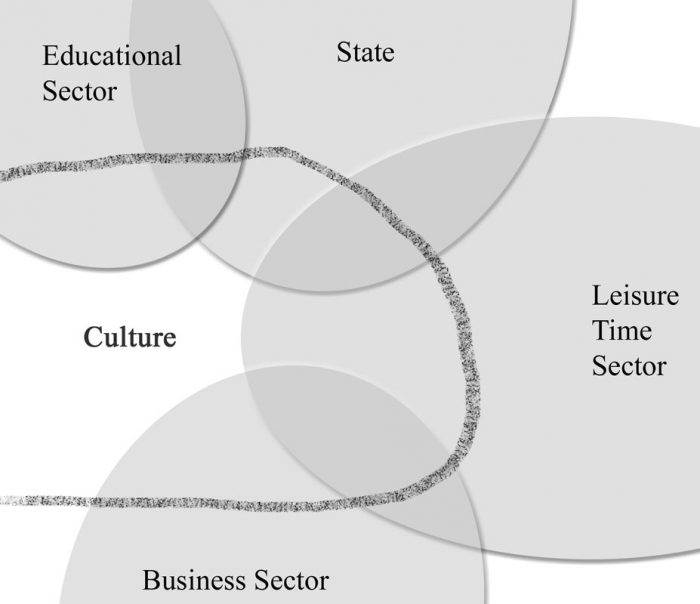
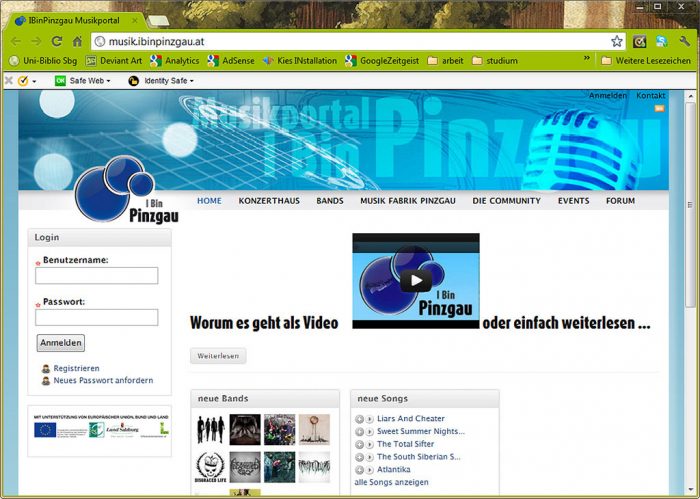
 Artikel drucken
Artikel drucken Literaturverzeichnis
Literaturverzeichnis